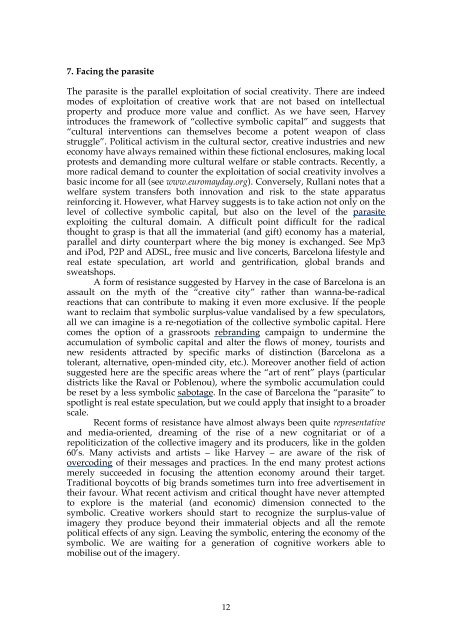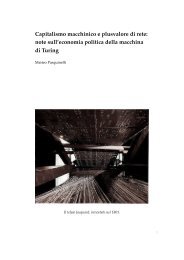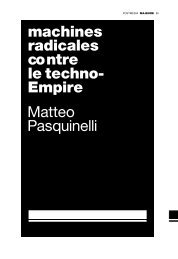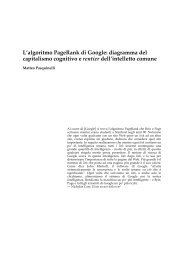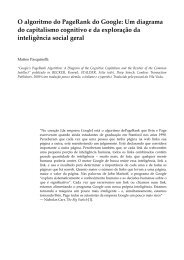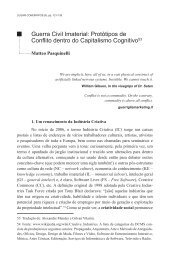Immaterial Civil War - Matteo Pasquinelli
Immaterial Civil War - Matteo Pasquinelli
Immaterial Civil War - Matteo Pasquinelli
You also want an ePaper? Increase the reach of your titles
YUMPU automatically turns print PDFs into web optimized ePapers that Google loves.
7. Facing the parasiteThe parasite is the parallel exploitation of social creativity. There are indeedmodes of exploitation of creative work that are not based on intellectualproperty and produce more value and conflict. As we have seen, Harveyintroduces the framework of “collective symbolic capital” and suggests that“cultural interventions can themselves become a potent weapon of classstruggle”. Political activism in the cultural sector, creative industries and neweconomy have always remained within these fictional enclosures, making localprotests and demanding more cultural welfare or stable contracts. Recently, amore radical demand to counter the exploitation of social creativity involves abasic income for all (see www.euromayday.org). Conversely, Rullani notes that awelfare system transfers both innovation and risk to the state apparatusreinforcing it. However, what Harvey suggests is to take action not only on thelevel of collective symbolic capital, but also on the level of the parasiteexploiting the cultural domain. A difficult point difficult for the radicalthought to grasp is that all the immaterial (and gift) economy has a material,parallel and dirty counterpart where the big money is exchanged. See Mp3and iPod, P2P and ADSL, free music and live concerts, Barcelona lifestyle andreal estate speculation, art world and gentrification, global brands andsweatshops.A form of resistance suggested by Harvey in the case of Barcelona is anassault on the myth of the “creative city” rather than wanna-be-radicalreactions that can contribute to making it even more exclusive. If the peoplewant to reclaim that symbolic surplus-value vandalised by a few speculators,all we can imagine is a re-negotiation of the collective symbolic capital. Herecomes the option of a grassroots rebranding campaign to undermine theaccumulation of symbolic capital and alter the flows of money, tourists andnew residents attracted by specific marks of distinction (Barcelona as atolerant, alternative, open-minded city, etc.). Moreover another field of actionsuggested here are the specific areas where the “art of rent” plays (particulardistricts like the Raval or Poblenou), where the symbolic accumulation couldbe reset by a less symbolic sabotage. In the case of Barcelona the “parasite” tospotlight is real estate speculation, but we could apply that insight to a broaderscale.Recent forms of resistance have almost always been quite representativeand media-oriented, dreaming of the rise of a new cognitariat or of arepoliticization of the collective imagery and its producers, like in the golden60’s. Many activists and artists – like Harvey – are aware of the risk ofovercoding of their messages and practices. In the end many protest actionsmerely succeeded in focusing the attention economy around their target.Traditional boycotts of big brands sometimes turn into free advertisement intheir favour. What recent activism and critical thought have never attemptedto explore is the material (and economic) dimension connected to thesymbolic. Creative workers should start to recognize the surplus-value ofimagery they produce beyond their immaterial objects and all the remotepolitical effects of any sign. Leaving the symbolic, entering the economy of thesymbolic. We are waiting for a generation of cognitive workers able tomobilise out of the imagery.12


